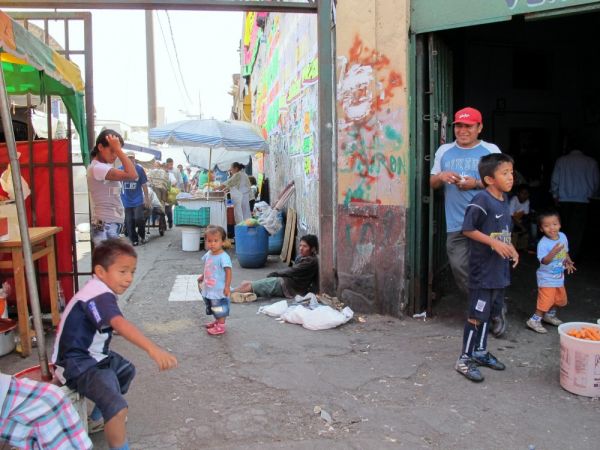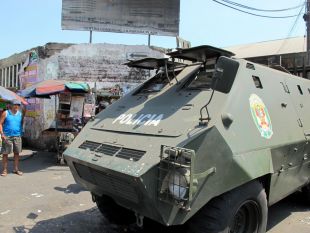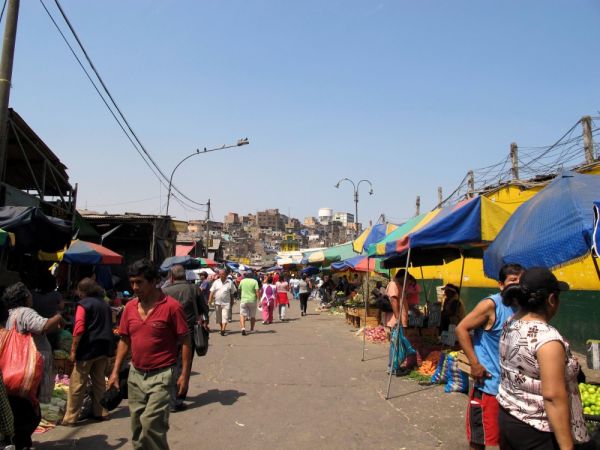Through Riots and Police Barricades, a Market for the Poor Staggers On

La Parada is an important point of commerce for some of Lima’s poorest citizens, who can’t afford the high rents of the new Santa Anita market the city wants to move them to. Photo credit: Manuel Vigo
For decades Lima’s La Parada wholesale market was the quintessential symbol of the city’s informal realm. Its notoriously high crime levels were surpassed only by its nonexistent health and safety standards. Stolen and black-market goods were bought and sold there. But the market was also an important pillar of the city’s working class, and a reflection of poorer residents’ desire for upward mobility.
The market provided a critical link between Peru’s producers and consumers, as many vendors would buy their goods wholesale there before taking them out to the street to sell them at a profit. But the bustling commerce at La Parada came to a screeching halt last year when the city decided to close the market and encourage the traders to move to the purpose-built Santa Anita wholesale market instead. Santa Anita, a sprawling 60-acre outdoor mega-mall, dwarfs La Parada, which is only about three acres. Officials predicted the new market would see 9 million soles ($3.5 million USD) in transactions each day, double that of La Parada. Santa Anita’s opening brings to fruition a plan that’s been in the works since the 1960s.
Despite the optimistic forecasts, however, the proposal was met with animosity from La Parada’s occupants, who argued the city had no right to take away their place of business. Tensions between city officials and local traders finally erupted on October 25, when police placed large cement blocks on an access road to prevent supply trucks from entering. Close to one hundred police officers arrived at the market that day, equipped with riot gear. They were met by over 2,000 workers and security personnel. The clash that ensued left scores injured and two people dead.
News footage of the clashes at La Parada. Warning: Graphic content
At the time, Hermogenes Véliz Rivas, head of La Parada’s workers association, said the group would defend the market by any means necessary. “Police will not come in here,” Véliz said. “If there are any dead, it will be at the door.”
Two days later, deadly riots broke out again, leaving two more dead and hundreds injured. The riots were widely covered by local media, who broadcast footage of the violence and the looting, causing outrage among the city’s residents. Eventually the area was controlled, and police set up a permanent presence to watch over the entry to the market at all hours.

Police — and an armored tank — are now permanently stationed at the entrance to La Parada. Photo credit: Manuel Vigo
Still, a portion of La Parada’s vendors refused to move to Santa Anita, arguing that rent at the new market was far too high, and that customers would not follow them over. Those who could not afford to go to Santa Anita had to look for other markets where they could set up shop.
The story of La Parada and Santa Anita illustrates a stubborn issue that often resides at the crux of formal and informal in Lima. What’s good for the city’s poorest citizens – the ones who benefit most from La Parada – sometimes causes problems for the city at large, which must cope with the urban ills for which the market is a haven. The strain at La Parada is palpable – most vendors refused to talk to me the day I visited, perhaps a reflection of the negative way they feel they are portrayed in the media. As I walked among the stands, workers eyed my camera warily. “Why are you taking pictures without people’s permission?” one shopkeeper shouted. It’s a vivid example of the tension that separates private and public interests, as well as more complex issues involving some of the city’s most impoverished residents, who are looking for ways to carve out a space of their own and make a living in an increasingly upscale city.
These days the Santa Anita marketplace continues to see sustained growth, and is being touted as a success story for a city trying to bring order to its haphazard market system. In February, the city said some 8,000 vehicles entered Santa Anita every day — more than double what was seen when the market first opened its doors in September.
But La Parada has yet to permanently shut down. Last week Judge Malzon Urbina, head of the 56th criminal court of Lima, ordered the market to be reopened, arguing that the city had not complied with due process when it closed it. It took traders only a few days to reoccupy the land. Indeed, within a week, La Parada’s streets had once again become a central hub for the city’s informal workers.

Despite the city’s efforts to shut it down, La Parada remains open and bustling. Photo credit: Manuel Vigo
The ruling was a blow for Mayor Susana Villarán, who touted La Parada’s closure as a major step toward modernizing the city, and who was left politically scarred after narrowly surviving an attempt to remove her from office earlier this year. But for the city’s poorer informal workers, it was a respite from having to pick up and move to an unfamiliar place where business might not be so brisk.
Several people I talked to told me to be careful while visiting La Parada, as tensions were high and thieves were apparently once again on the prowl. “If you go over to the market, hide your camera and be careful,” said Joanna, a shopkeeper at a neighboring market. When I arrived, La Parada seemed to be back to its old self. Parcels of food were stacked high and the maze-like streets were bustling with people, all of them in a hurry to get their orders in. Young men pushed large crates of fruit on creaky carts. Dogs weaved in and out of the stalls. The smell of urine was pungent, and empty trash bags cartwheeled by me like tumbleweeds.
Two women sitting on the ground, hunched behind a heap of potatoes and a white bucket full of carrots, offered their produce. A group of men carrying large wooden crates scurried by on the sidewalk. Towards the market’s entrance a young woman in her twenties sold school supplies. I asked her why she decided to come back to La Parada. “Sales are better here,” she said – curtly, after realizing I was not interested in actually buying anything from her.
If anything, the only difference between the old La Parada and the new one was a nearby police officer leaning next to a menacing armored tank, parked just outside the market’s gates. He warned me not to venture too far into the market, as there had been reports of thefts. But when I asked if there have been any major developments since the traders returned, his answer surprised me.
“Nothing,” he said. “Everything is the same.”









